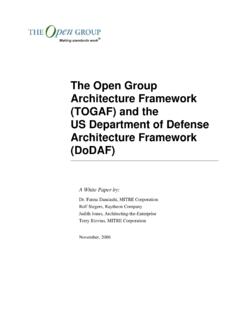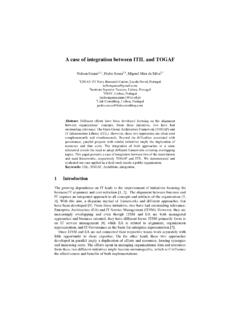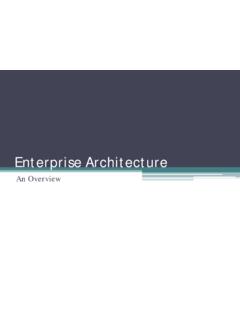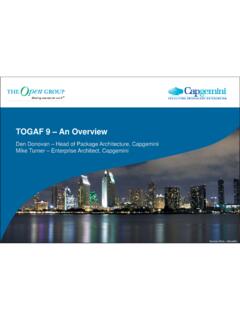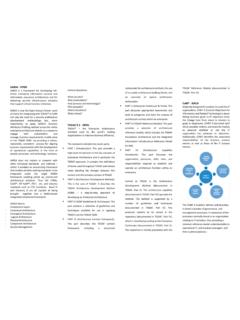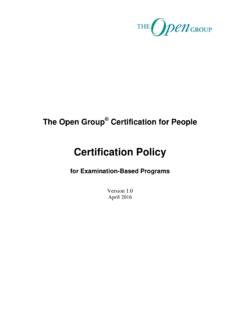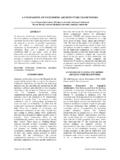Transcription of Guide to Security Architecture in TOGAF ADM
1 Guide to Security Architecture in TOGAF ADM A White Paper developed by: The Open Group Security Forum and Members of The Open Group Architecture Forum November, 2005 Guide to Security Architecture in TOGAF ADM A White Paper Published by The Open Group 2 Copyright 2005 The Open Group All rights reserved. No part of this publication may be reproduced, stored in a retrieval system, or transmitted, in any form or by any means, electronic, mechanical, photocopying, recording, or otherwise, without the prior permission of the copyright owners. Boundaryless Information Flow is a trademark and Making Standards Work , UNIX , and The Open Group are registered trademarks of The Open Group in the United States and other countries. All other trademarks are the property of their respective owners. Guide to Security Architecture in TOGAF ADM Document No.
2 : W055 Published by The Open Group, November, 2005 Any comments relating to the material contained in this document may be submitted to: The Open Group 44 Montgomery St. #960 San Francisco, CA 94104 or by email to: Guide to Security Architecture in TOGAF ADM A White Paper Published by The Open Group 3 Table of Contents Executive Summary 4 Introduction to Security Architecture Guidance in the ADM 5 ADM Security Guidance for ADM Architecture Requirements Management 8 Approach ..8 Security Security Guidance for Preliminary Phase: Framework and Principles11 Approach ..11 Security Security Guidance for Phase A: Architecture Vision 14 Approach ..14 Security Security Guidance for Phase B: Business Architecture 17 Approach ..17 Security Security Guidance for Phase C: Information System Architectures 22 Approach.
3 22 Security Security Guidance for Phase D: Technology Architecture 26 Approach ..26 Security Security Guidance for Phase E: Opportunities and Solutions 29 Approach ..29 Security Security Guidance for Phase F: Migration Planning 32 Approach ..32 Security Security Guidance for Phase G: Implementation Governance 35 Approach ..35 Security Security Guidance for Phase H: Architecture Change Management 37 Approach ..37 Security About The Open Group 41 Guide to Security Architecture in TOGAF ADM A White Paper Published by The Open Group 4 Boundaryless Information Flow achieved through global interoperability in a secure, reliable, and timely manner Executive Summary The Open Group Architecture Framework ( TOGAF ) is now well-established in the IT Architecture industry.
4 The core of TOGAF is its Architecture Development Method (ADM). Development of TOGAF ADM has matured and extended in its coverage over many years now. The latest published version is TOGAF8. Coverage of information Security considerations in TOGAF ADM has, for several years, been acknowledged as a significant omission. In late 2004, The Open Group Security Forum undertook a collaborative project with members of the Architecture Forum to correct this omission. The result is this White Paper. The goal of this White Paper is to explain what Security considerations need to be addressed in the TOGAF ADM for the guidance of enterprise architects and system designers. Its primary purpose is as input to the Architecture Forum, for integrating Security considerations into their development of the next version of TOGAF (designated TOGAF9).
5 We also anticipate it will be of value to system architects and designers who include information Security considerations in their designs. The work in developing this White Paper is based on the existing published TOGAF -8, so the Security Forum and our collaborators from the Architecture Forum appreciate that there may be new considerations arising in TOGAF9 development that we will want to re-visit when TOGAF9 becomes sufficiently stable. It is significant to note that during this development project, several Security -related Architecture and design issues arose which the information Security experts wanted to include in this White Paper, but which were ruled as out of scope of the coverage of TOGAFADM. Follow-on work will aim at a minimum to capture these issues and make them available from the Security Forum web site ( ).
6 Guide to Security Architecture in TOGAF ADM A White Paper Published by The Open Group 5 Introduction to Security Architecture Guidance in the ADM ADM overview The TOGAF Architecture Development Method (ADM) is the result of continuous contributions from a large number of Architecture practitioners. It describes a method for developing an enterprise Architecture , and forms the core of TOGAF . It integrates elements of TOGAF as well as other available architectural assets, to meet the business and information technology needs of an organization. The TOGAF Architecture Development Method (ADM) forms the core of TOGAF . It is a method for developing an enterprise Architecture to meet the business and information technology needs of an organization, utilizing the other elements of TOGAF described in this document, and other architectural assets available to the organization.
7 Architectural development in the process of the ADM is iterative in nature, in that as the development of the Architecture progresses, many areas of concern are revisited but at a finer-grained level of examination. Through the several phases the reader might see topics repeated, or in an earlier phase a topic might be treated at a higher level than the reader might expect. Architecture development methods are also tools in the hands of the practitioner to be used as best fits the practitioner's experience. The guidance included here is intended to help practitioners avoid missing a critical Security concern. It is expected that elements included by the authors in specific phases will be modified and shifted according to the practitioner's experience. This Guide is not intended to be a Security Architecture Development Methodology.
8 It is intended for the enterprise architect deploying TOGAF ADM, to inform the enterprise architect of what the Security architect will need to carry out their Security Architecture work. It is also intended as a Guide to help the enterprise architect avoid missing a critical Security concern. Discussion of Security Architecture has the tension of being separate from the remainder of enterprise Architecture development and at the same time needing to be fully integrated in it. The focus of the Security architect is enforcement of Security policies of the enterprise, which at times can be seen as inhibiting advancement of projects undertaken by the enterprise architect and application development team. Security architects spend a good deal of effort proving the negative. Characteristics of Security Architecture Security Architecture has its own methods.
9 These methods might be the basis for a discreet Security methodology. Security Architecture composes its own discrete view and viewpoints. Security Architecture addresses non-normative flows through systems and among applications. Security Architecture introduces its own normative flows through systems and among applications. Security Architecture introduces unique, single-purpose components in the design. Security Architecture calls for its own unique set of skill requirements in the IT architect. Guide to Security Architecture in TOGAF ADM A White Paper Published by The Open Group 6 Guidance on Security for the Architecture Domains Pervasively throughout the architectural domains and in all phases of the Architecture development, Security concerns of the enterprise need to be accounted for. Security is called out separately because it is infrastructure that is rarely visible to the business function being added to the target Architecture to derive value.
10 Its fundamental purpose is to protect the value of the systems and information assets of the enterprise. The nature of Security in the enterprise is that it is deemed successful if nothing happens that is visible to the user or other observer, and no damage or losses occur. That is, if the enterprise retains the use and value of its information assets, the goals of Security in the enterprise have been met. These assets might be obvious like the data in a customer records database or intangible like not having the company name appear in an article in the news saying that its data systems had been compromised. While Security Architecture does have its own single-purpose components, Security is experienced as a quality of systems in the Architecture . As salt is a separate seasoning, it becomes part of the quality of the dish once it is used.
